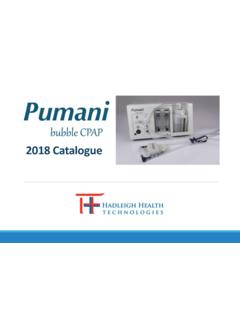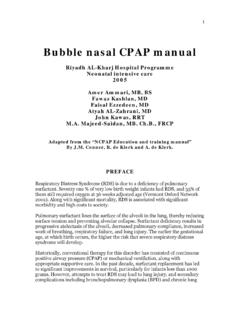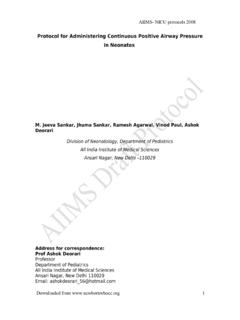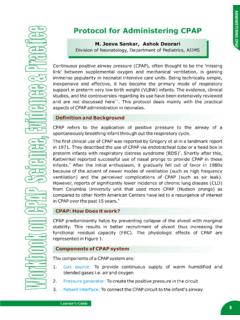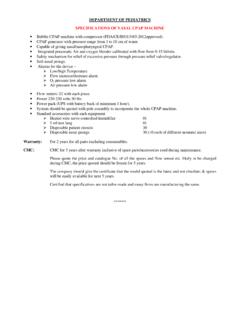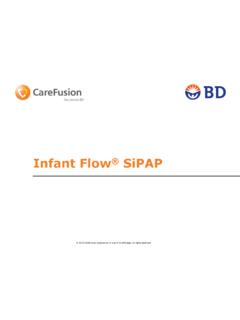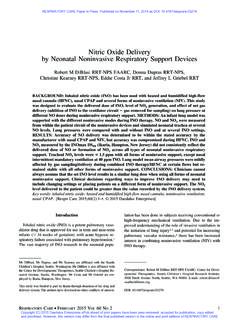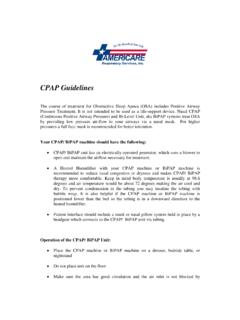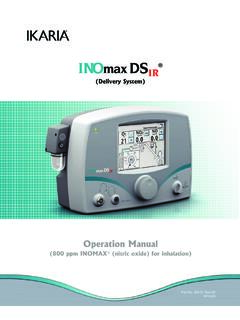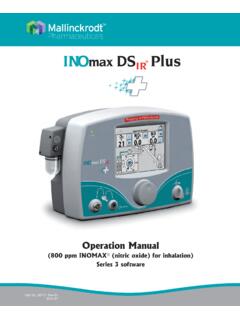Transcription of Pumani CPAP User Manual - Wild Apricot
1 Pumani cpap User Manual IntroductionRespiratory failure is a leading cause of neonatal mortality in the developing world. Bubble continuous positive airway pressure (bCPAP) is a safe, effective intervention for infants with respiratory distress and is widely used in developed countries. The Pumani bCPAP is a low-cost, easy-to-use, easy-to-repair device to treat infants in respiratory distress, and it has been designed specifically to operate in low-resource settings. Clinical results show that use of the Pumani bCPAPcan significantly reduce neonatal mortality in low-resource Pumani bCPAP has been developed at the Rice 360 : Institute for Global Health Technologies at Rice University in Houston, TX, in partnership with Queen Elizabeth Central Hospital and the College of Medicine in Blantyre, Malawi;the Malawi Ministry of Health; Baylor College of Medicine and Texas Children s Hospital in Houston, TX; and 3rdStone Design in San Rafael, CA.
2 Table of ContentsPart I: How to Assemble the Pumani CPAP4 Pumani cpap Components5 Assembly Instructions6-16 Part II: How to Prepare the Baby for CPAP17 Part III: How to Attach the Baby to the Pumani CPAP20 Prong & Hat Components21 Attachment Instructions22-27 Part IV: How to Monitor the Baby28 Part V: Disinfection Instructions 32 Part VI: Troubleshooting34 Pumani cpap Troubleshooting35 Prong Troubleshooting36 Part VII: Pumani cpap Repair Instructions37 Appendix A: Setting the Flows for a Specific Percent O248 Part I: How to Assemble the Pumani cpap 4 Pumani cpap Tubing Tubing Flow Flow and Port Cord9 Step 1: Filling and Connecting the bottle into bottle strap and connect the bottle tubing to the bottle and to the Pumani cpap bottle with water and attach the lid to the bottle.
3 Most patients start at 6 cmof water 2: Connecting the Patient Tubing7 Connect the patient tubing to the Pumani cpap at the patient tubing 3: Determining Prong the patient s weight as a guide to choose the prong size. prong size is located between the nasal prongs. You can use the prong size guide on the next page to determine the prong 4: Prong Size Guide9 Place the nasal prongs on the pictures to determine the prong 5: Checking Prong the prong size by placing the prongs in the patient s nose. The prongs should be placed curved-side down, as shown. The prongs should completely fill each nostril. Immediately remove the the nostrils are not completely filled, air will leak and the patient will not get the necessary pressure .
4 You will need to replace the prongs with the next largest prong 6: Connecting the the other side of the prongs to the patient tubing. Straight the elbow connector to one side of the prongs. Step 7: Checking the Pumani cpap Assembly12 Make sure all of the cpap components are properly Tubing and 8: Turning the Pumani cpap the power cord to the back of the Pumani cpap and to an electrical on the Pumani cpap power switch. A red light should be lit when the Pumani cpap is 9: Attaching the Oxygen Concentrator14If the patient needs the oxygen flow meter on the Pumani cpap . tubing from the oxygen concentrator to the O2port. Make sure the oxygen concentrator is turned on.
5 If the patient does not need oxygen:-Do not connect the oxygen the oxygen flow 2. 15 Step 10: Determining Oxygen Flow and Blended FlowMost patients will start at the same settings:Set the concentrator then the oxygen flow then the blended flowConcentrator FlowOxygen FlowBlendedFlowNeonate3 L/min3 L/min6 L/minChild4 L/min4 L/min6 L/min1 2 3*For a larger range of flow options, see Appendix A. the prongs. Water in the bottle should fingers from prongs. Bubbling should the bubbling does not start or stop, refer to the Pumani cpap troubleshooting (page 35). the Pumani cpap off and continue to Part II: How to Prepare the Baby for 11: Checking the Bubbling Function16 Part II: How to Prepare the Baby for from the nose to the ear and halfway back to determine suction depth of the nose.
6 For example: if the distance is 6 cm, the depth should be 9 cm (6+3 = 9). remove the O2tube from the nose. Put a drop of saline in one nostril, insert the tube to the determined depth, then cover the suction port as you pull out the suction tube. in the other the O2tube back into the the 1: Suctioning the Nose & from the mouth to the ear, and then to the bottom of the note of the the OG tube in the mouth to this that the OG tube is in the stomach by placing the end of the tubing in water. If it does not bubble, it is in the correct place. (You can also aspirate the OG tube with a syringe to check for stomach contents.) the OG tube to the : if the abdomen is distended, consider aspirating the tube with a 2: Inserting the OG TubePart III: How to Attach the Baby to the Pumani CPAP20 These are the items you need to attach the prongs to the baby:21 Prongs & Hat hat size based on size of the patient s length and cut stockinette.
7 Stockinette in the one half of the stockinette over the other half. bottom edge 3 times to make a 5-cm brim. Step 1: Making the Hat22 Hat SizeStockinette LengthStockinette WidthSmall61 cm (24 in)2 inchMedium66 cm (26 in)3 inchLarge71 cm (28 in)4 hat on the patient. Make sure that the hat fits tightly to prevent the prongs from moving. The back of the hat should be low, near the baby s neck. Hat may need to be replaced at least every 24 hoursto keep a tight fit on the baby s 2: Placing the Hat on the Patient23 Step 3: Inserting the on the Pumani cpap . sure the flows are still set correctly. saline drops in the the prongs into the nose. There should be a cm space between the prongs and the nose.
8 Do not use creams or ointments, as these can cause breakdown of the tissue and block the the prongs on the hat (you can mark on the hat where the pins should be placed). Make sure the prongs stay in the : place fingers under the brim of the hat to maintain space between the hat and the head when placing the safety pins. two safety pins through each side of the hat. Keep the sharp end of the pin away from the patient s face. Do not put the pins all the way through to the baby s head. The pins should never be in contact with the 4: Attaching the Safety the tubing between the pins. the elastic over one pin, across the tubing, and over the other pin. the other elastic over the 2 pins on the other side of the 5: Attaching the ProngsStep 6: Check the Prongs27 HatSafety PinsElasticProngsPatient TubingThis is how the prongs should appear once they are attached: cm space between the prongs and the nosePart IV: How to Monitor the measure the respiratory rate: Uncover the patient s abdomen so you can view the chest.
9 Press the respiratory rate timer to start the 60-secondcount. As soon as you press the timer, begin counting the patient s breaths. The timer will beep once after 30 seconds do not stop counting. When the timer beeps twice, stop counting. Record the respiratory the Respiratory the patient is settled on the Pumani cpap , the respiratory rate should be the patient is settled on the Pumani cpap , the oxygen saturation should be checked with a pulse the pulse ox probe on the patient. For smaller babies, wrap the probe around the palm of the baby s hand For larger babies, place the finger probe on the patient s the pulse oximeter the waveform for 1-2 minutes until it looks Waveform: Bad the oxygen saturation and heart the oxygen saturation is <90%, increase the oxygen flow rate by 1 the Oxygen Saturation31 Patient Monitoring Checklist What to Check ForResponseIs the power on?
10 If the power is NOT on: Remove the prongs immediately Place the patient on oxygen If possible, take the Pumani cpap to a ward with power Document how long the patient was off cpap and how long the patient was on oxygenAre the nostrils moist?If the patient s nostrils are not moist: Placesaline drops in the patient s nostrilsAre the prongs in the patient s nose?If the prongsare not in the patient s nose: Re-insert the prongs into the patient s nose You may need to reposition the hat,pins, or elastics to keep the prongs in placeIsthe hat tight on the patient s head?If the hat is nottight on the patient s head: Remove the hat and replace the hat with a new hatPart V: Disinfection Instructions32 Instructions for DisinfectionAfter each patient on 2 L of oxygen, turn off the Pumani cpap , and place elastics and pins in the storage away the hat and OG tube.
